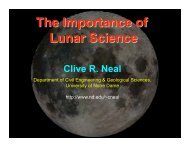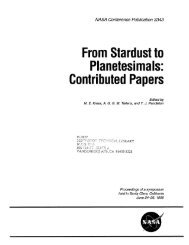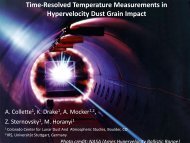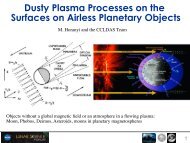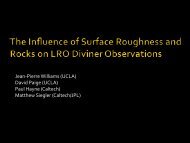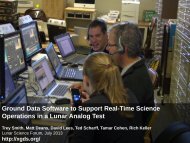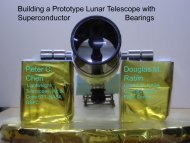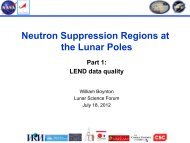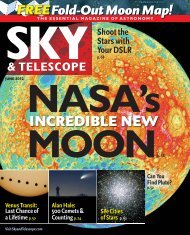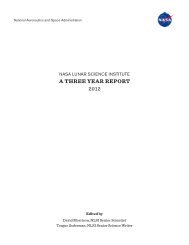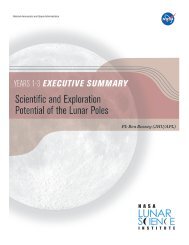Analysis of bevameter - NASA Lunar Science Institute
Analysis of bevameter - NASA Lunar Science Institute
Analysis of bevameter - NASA Lunar Science Institute
Create successful ePaper yourself
Turn your PDF publications into a flip-book with our unique Google optimized e-Paper software.
<strong>Analysis</strong> <strong>of</strong> <strong>bevameter</strong>/<br />
regolith interaction<br />
mechanics using the COUPi<br />
discrete element method<br />
P. Duvoy 1 , C. Creager 2 , A. Kulchitsky 1 , J.B. Johnson 1<br />
1<br />
University <strong>of</strong> Alaska-Fairbanks, 2 <strong>NASA</strong> Glenn Research Center
Introduction<br />
Bevameter technique was developed to<br />
measure terrain mechanical properties<br />
for the study <strong>of</strong> vehicle mobility<br />
Bevameter test consists <strong>of</strong> penetration<br />
test to measure normal loads and<br />
shear test to determine shear loads<br />
exerted by vehicle.<br />
Bevameter area size need to be the size<br />
<strong>of</strong> the wheel or track. DEM analysis can<br />
take data from one size and simulate<br />
<strong>bevameter</strong> performance for a different<br />
size.
COUPi DEM<br />
COUPi is a discrete element method model developed<br />
as part <strong>of</strong> a <strong>NASA</strong> <strong>Lunar</strong> <strong>Science</strong> <strong>Institute</strong> project<br />
It can model interactions between particles <strong>of</strong><br />
different shapes including polyhedra and machines<br />
The model has a computational “core” and “scenario”<br />
scripts allowing to build new tests and extend the<br />
model
Physical Controlling<br />
Parameters
COUPi Bevameter Tests<br />
Import the modeled <strong>bevameter</strong> shapes into the<br />
COUPi simulations using the CAD function.<br />
Compare measured results from laboratory<br />
<strong>bevameter</strong> tests to COUPi simulation runs using<br />
similar material properties for the particles (GRC-1<br />
lunar simulant) with varying bulk densities.<br />
Analyze the effects <strong>of</strong> containers <strong>of</strong> different size in<br />
the simulation results.
COUPi CAD Module<br />
Image cup and shear<br />
ring from <strong>NASA</strong> Glenn<br />
Cup and shear ring imported from<br />
manufacturer STEP model into COUPi
COUPi CAD Module<br />
Image <strong>of</strong><br />
flat plate<br />
from <strong>NASA</strong><br />
Glenn<br />
Flat plates modeled in Autodesk Inventor<br />
Flat plate imported into COUPi
Bevameter setup<br />
<strong>NASA</strong> Glenn <strong>bevameter</strong>
Particle Size Distribution<br />
Log-normal PSD by spherical equivalent diameter<br />
100%<br />
90%<br />
80%<br />
70%<br />
60%<br />
50%<br />
40%<br />
30%<br />
20%<br />
10%<br />
Percent Finer<br />
Mean Radius = 3.0<br />
mm (d50 = 8.09<br />
mm)<br />
10<br />
5<br />
Particle Diameter [mm]<br />
0<br />
0%
COUPi Sinkage Test Simulation<br />
7.5 cm Plate Diameter – B.D. 1.70 – 2x Area
COUPi Shear Test Simulation<br />
2.5 cm Grouser Height – B.D. 1.70 – 1x Area
Sinkage Test – 7.5 cm Plate Diameter – 1x Area
Sinkage Test – 10 cm Plate Diameter – 1x Area
Sinkage Test – 20 cm Plate Diameter – 2x Area
Shear Test – 2.5 cm Grouser Height – 5 kPa Load –<br />
1x Area
CT Scans <strong>of</strong> GRC-3<br />
100<br />
80<br />
Percent Finer<br />
60<br />
40<br />
Diameter: 47<br />
μ<br />
20<br />
0<br />
1.000<br />
Diameter:<br />
422 μ<br />
Diameter:<br />
287 μ<br />
0.100<br />
Diameter:<br />
166 μ<br />
Particle Diameter, mm<br />
0.010<br />
0.001
COUPi 3D CPT Simulation
COUPi Triaxial Test Simulation
Conclusions<br />
Plate pressure and ring shear pressure results <strong>of</strong><br />
simulations were generally in concordance or lower (in<br />
the case <strong>of</strong> the smaller flat plate) than laboratory tests,<br />
more runs are needed to calibrate simulation<br />
parameters.<br />
Faster penetration velocities produce higher<br />
oscillations in the simulations.<br />
Bigger soil containers minimized boundary effects, but<br />
computational resources usage increased greatly.<br />
More results needed for smaller size particles, different<br />
friction between particles, and shapes.



